Overview
Description
Bigelow Tea - Black Tea Constant Comment - 20 Tea Bags (1.18 oz. / 33 g)
Bigelow Tea Constant Comment Tea is flavored with rind of oranges and sweet spice. Created by Ruth Bigelow in her kitchen over 60 years ago "Constant Comment" is today America's most popular specialty tea. This original blend of the finest mountain-grown tea is deliciously flavored with rind of oranges and sweet spice. There's no other tea in the world quite like it. 20 individually foil wrapped tea bags per box.
Black Tea
When Ruth Bigelow created "Constant Comment" tea in her kitchen in 1945, little could she ever have imagined that one day it would be America's most popular specialty tea. Truly an American classic, it has satisfied generation after generation of tea drinkers for over 60 years. Today the Bigelow Tea Company has many wonderful flavors in tea for you to enjoy. And, most importantly, each and every tea bag is overwrapped and sealed in a stay fresh foil packet so that all the goodness is protected until you get ready to have a cup of tea.
History of Tea
From Buddhist monks using it in their religious ceremonies to American revolutionaries tossing it in to Boston Harbor, tea has become more than a beverage; it has become an event. For nearly 5,000 years this drink has been a source of medicine, meditation, piracy, political upheaval, social order, congregation, and superstition. While the roles tea has played in Eastern and Western civilization are abundant, it is derived from a plant native to Central and Eastern Asia.
Botanically, the tea they drink is of the genus camellia and the species sinesis. This temperamental plant, which is greatly affected by variations of soil, elevation, and climate, originated in Central Asia and can be separated into three basic types: black, green, and oolong. The process used to prepare the leaves establishes the tea's classification, while oxidation determines its color, body, and flavor. With black teas, the leaves are withered, rolled, sifted, and fermented, delivering a hearty flavor and rich amber color. Black teas, which account for approximately ninety percent of U.S. tea consumption, include such favorites as Orange Pekoe, English Breakfast, and Darjeeling. To produce green teas, the leaves are fired shortly after harvesting to prevent fermentation, yielding a greenish gold color and a delicate taste. Recent studies have shown that this tea can help reduce the risk of cancer. With oolong teas, the leaves are withered, rolled, twisted, and semi-fermented, producing a color and flavor that falls between that of black and green teas. Although herbal teas are designated as teas, they are not comprised of any tea leaves. Instead, these herbal teas contain peels, grasses, berries, leaves, flowers, and flavorings from a variety of plants.
As each variety of tea has evolved through centuries of refinement, the origin of the first tea is clouded by myth. The origin of tea dates back so far that it would have been forgotten long before the birth of Christ save Asian oral tradition. Accordingly, the event, which led to the discovery of tea, has transcended the historical and entered the realm of folklore. Thus, the particulars of the account are varied and debated. Considering tea is indigenous to both India and China, each culture originally staked claim to inventing this invigorating beverage.
According to Chinese legend, Emperor Shen Nong, revered for his knowledge of agriculture and medicine, mandated, presumably for health reasons, that his subjects boil water before drinking it. While preparing his water one day, a light wind deposited several tea leaves into his boiling pot. The aroma enticed Shen Nong to sample the pot's contents. At once he found the flavor to his liking and his body rejuvenated. Other versions of the tale cite that the source of the tea leaves was not from a tree above the pot, but rather from a camellia branch which was fueling the flames below it. Still others attempt to validate the authenticity of the event by affixing a date to Shen Nong's experience, asserting that it occurred in either 2737 BC or 2690 BC.
The Buddhist chronicle of the genesis of tea follows the mythical religious pilgrimage of Siddhartha Gautama, a Nepalese prince and historic founder of Buddhism. Siddhartha eager to prove his faith journeyed to China, pledging to forego sleep during his trip. Wearisome after days of travel, Siddhartha breached his vow and slept. Upon waking, he cursed his eyelids and promptly removed them, throwing them to the ground. To his dismay, the eyelids quickly buried into the soil and within moments sprouted a tea bush. Siddhartha partook in the leaves of the bush, and immediately his tired body was replete with energy.
While it is most likely that neither tale actually occurred, it is notable that tea was held in such high regard that a tea creation story was formulated and preserved by both the Chinese and Buddhists respectively. Considering the peoples of Central and Eastern Asia initially used tea as an antidote to the overpowering effects of alcohol, it is not surprising that such mythical tales of tea's beginnings were formed. But it was the Buddhists who harnessed the mysticism surrounding tea. In the humble and highly symbolic Buddhist tea ceremony, followers retire to a chamber that is apart from the troubled world. In this almost barren tea room, they ritualistically consume tea offered by a tea master, all the while focusing on peace and simplicity. This exercise, which may take up to three years to perfect, is exemplary of the harmonious teachings of the faith. As tea became a staple of Asian culture, most notably as China's national drink, it was not poised to make an economic impact until the eighth century when Lu Yu published Ch'a Ching, the definitive tea production manual. At the time, tea, no longer confined to medicinal and religious purposes, had become a beverage of choice, but production methods for tea were varied and disconnected. Yu's work, part poetry, part production guide, brought uniformity to how tea should be cultivated, manufactured, and infused. He also detailed the paraphernalia necessary to properly prepare and consume tea. With this information, tea flourished in China, but it would not be until the seventeenth century that tea gained a direct route to England.
In 1600, Queen Elizabeth, longing for exotic luxuries, founded the East India Company to procure fine woven cloths, spices, herbs, and other riches from the East. Although it would not be until 1664 before this enterprise would deliver tea to the shore of England, six years after the first documented tea drinker on English soil took a sip, the East India Company held exclusive rights to English-Oriental trade until 1833. At first, the East India Company's tea shipments were meager and subject to tariffs. Consequently, enterprising merchants of the piratical sort ignored the imposed monopoly and illegally imported tea. These contraband shipments not only increased the supply of tea on mainland England but also stimulated its sale and allure by offering this forbidden tea at a lower price. Thus, tea was no longer reserved for high society England, and by the middle of the eighteenth century had replaced ale as England's national drink.
Accordingly, as tea drinking blossomed in England, so too did it in the English colonies. By the turn of the eighteenth century, tea was publicly available in colonial Boston, New York, and Philadelphia. Unfortunately, the colonial tea trade was almost exclusively with the Mother country. England soon placed increasingly higher tariffs on tea as a way to recoup the expense of the French and Indian War. These tea taxes prompted the colonists to take action. On December 16, 1773, a band of some sixty outraged colonists, disguised as Indians, gathered at Griffin's Wharf, boarded the Dartmouth, the Eleanor, and the Beaver, and tossed hundreds of pounds of tea into Boston Harbor. Known as the Boston Tea Party, this event was a catalyst to the colonists fight for independence.
Following the Revolutionary War, America staked its own claim in the Chinese tea trade, and by the turn of the twentieth century, tea became a source of social congregation. In both America and England, fine hotels housed tea courts and tea rooms, where men and women could gather in the late afternoon, sip tea, and exchange pleasantries. These tea rooms and tea courts soon moved to host tea dances, where spirits soared over the freedom and conveniences afforded by the ever evolving technology of the day.
During this time two particular tea discoveries were made almost accidentally. In 1904, Richard Blechynden, a tea vendor at the World's Fair in St. Louis, weary of selling his cups of hot tea in the summer heat, dropped ice in the beverage in an attempt to boost sales. The result was the first iced tea, which has since become a hallmark of supper tables in the American South. A second evolution of tea occurred in 1908 when Thomas Sullivan began to ship tea samples in individual bags to New York area restaurants. Sullivan soon discovered that the restaurants were preparing the tea without extracting it from the bag. Hence, bagged tea was born, allowing a tea connoisseur to effortlessly produce a hot cup of tea without notice.
Despite these modifications and evolutions, tea has retained its mystical aura through superstition. Tea historian J. M. Scott chronicles these superstitions:
To stir tea in the pot is to stir up strife. Bubbles in your cup show that kisses are coming, but if you put in milk before the sugar, you risk losing your sweetheart. If a girl allows a man to pour out a second cup of tea for her she will succumb to his designs. (I have been unable to discover whether it works the other way around.) And of course there is the advance information given by a floating tea-leaf that a stranger is coming, the number of taps with one hand it takes to shake it off the back of the other hand showing how many days there are to wait. People who make tea with water which is not boiling must expect a lot of strangers.
Whether you embrace these forecasts of the future or not, tea today is a symbol of healthy living, serenity, and an open hand. From young lovers rendezvousing to pass affections to businesspersons congregating to collaborate efforts, from a family gathering to discuss their day to old friends reuniting to exchange memories, tea can be found between them. Unquestionably, today's ubiquitous cup of tea continues to be an event maker. That event: bringing each of them closer together.
About Bigelow Teas
Founded in 1945 by Ruth Campbell Bigelow, R.C. Bigelow, Inc. is dedicated to being a premier packer of truly fine quality teas. As a family owned and operated business, their company is guided by the following four basic principles:
- Satisfied Consumers:
At Bigelow, the consumer is number one. Therefore, it is essential that they provide a product that satisfies all of their expectations. Bigelow Tea's primary focus is to produce teas that offer a unique and truly gratifying experience. In this endeavor, Bigelow will not allow price to compromise their products. Good flavor and product freshness are the prime considerations in the creations of their teas. - Strong Relationships:
With Bigelow's customers and suppliers they continually work to build and maintain strong business relationships. Bigelow Tea realizes that is through excellent communication and mutual respect, that they grow and prosper together. - Satisfied Employees:
Bigelow is an equal opportunity employer dedicated to providing their employees with a challenging and positive environment in which to work. Recognizing that each and every employee plays a pivotal role in the success of the company, they seek to attract and retain outstanding individuals who will take pride in all aspects of their areas of responsibility, and understand the importance of cooperation among their fellow employees. Bigelow Tea strives to motivate and satisfy their employees as well as promote individuals based on merit and contribution. - Good Corporate Citizen:
Bigelow Tea has been, and always will be based upon strong ethical business practices and is dedicated to only the highest standard of behavior in all areas. Bigelow Tea feels an obligation to support the local communities where they reside so as to build a good working relationship as well as to contribute to worthy local and national causes. Furthermore, as a good corporate citizen, they remain committed to protecting the environment by continually striving to improve the environmental responsiveness of their packaging. -
Community Involvement
Bigelow Tea is tireless when it comes to community involvement. For over 20 years, the Bigelow family and employees have given back to the communities where they work, especially in and around Fairfield, CT, the headquarters for Bigelow Tea. From the annual Bigelow Community Challenge Road Race to building homes for families in need, helping out with school mentoring programs, conducting book drives, and participating in business lecture programs for inner city school districts, employees love to get involved and give back over and over again. As part of the Bigelow Mission statement per Cindi Bigelow: "As good corporate citizens, they feel an obligation to support the local communities where they reside so as to build a good working relationship as well as to contribute to worthy local and national causes." The end result: they receive more than they give!
Suggested Use
Hot Tea: Pour boiling water over tea bag in a cup and steep for 1 to 2 minutes. Fresh Brewed Iced Tea by the Glass: Pour 4 to 5 fl. oz. boiling water over 1 tea bag. Steep 3 to 5 minutes. Sweeten to taste. Pour into tall glass filled with ice, and enjoy.
Ingredients
| Bigelow Tea - Black Tea Constant Comment - 20 Tea Bags | |||||||||||||||||||||||||||||||||||||||||||||||||||||||||||||||
|
|||||||||||||||||||||||||||||||||||||||||||||||||||||||||||||||
| Other Ingredients: black tea, rind of oranges, sweet spice, natural flavor Gluten Free | |||||||||||||||||||||||||||||||||||||||||||||||||||||||||||||||
Warnings
Questions & Answers
2 Reviews
Needless to say, after a week or so I quit using. They need to be smoother and actually have the ability to dissolve.






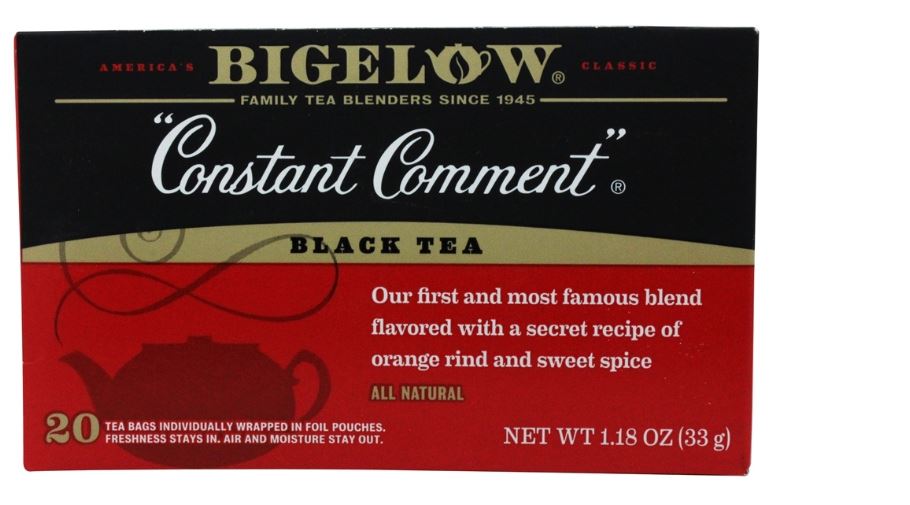

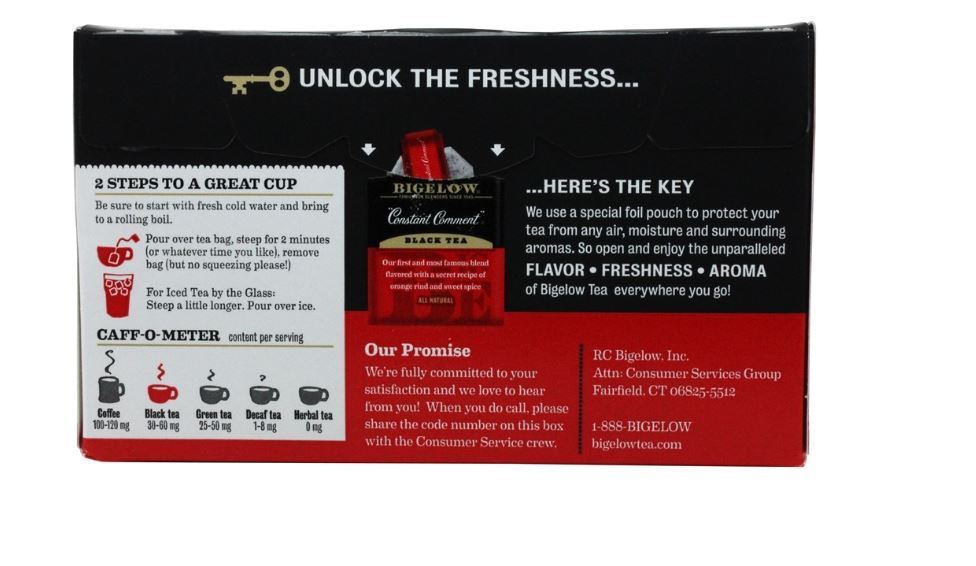
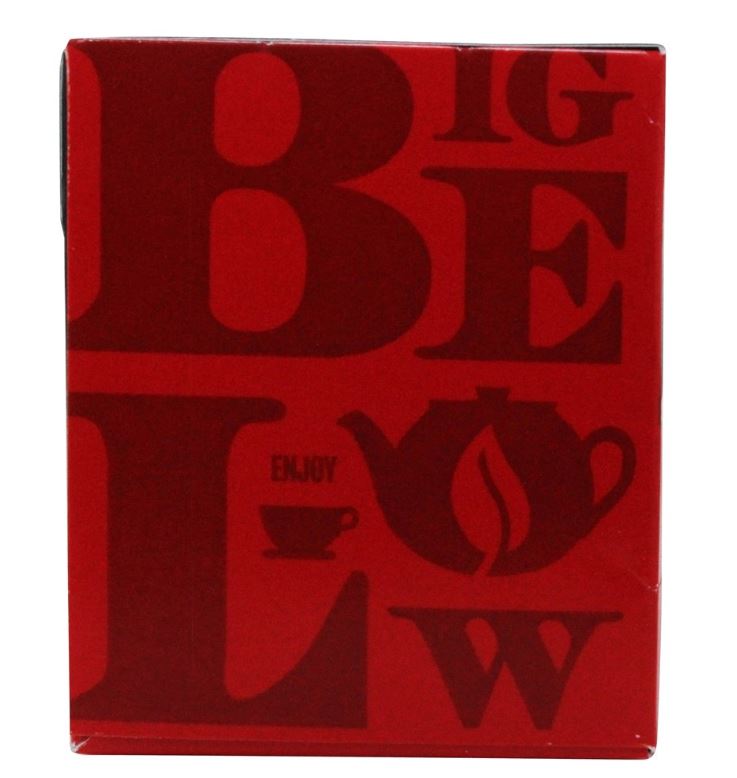
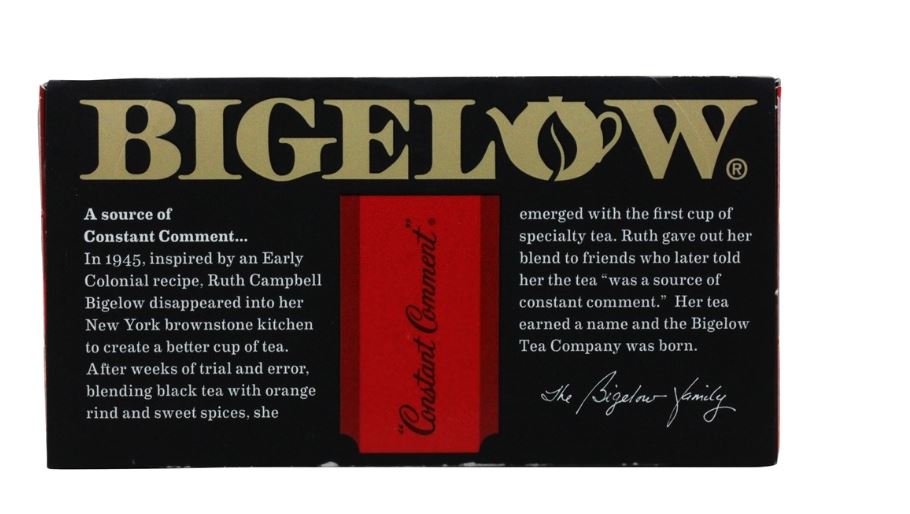
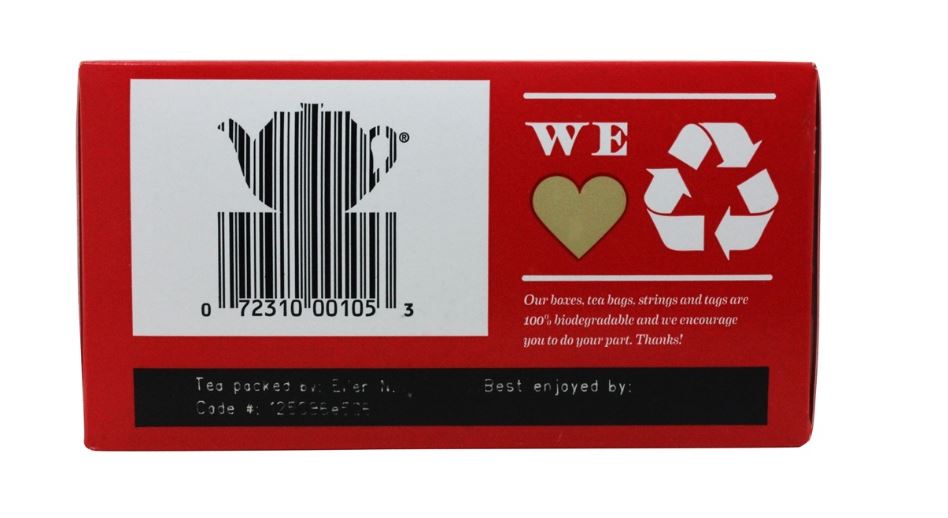
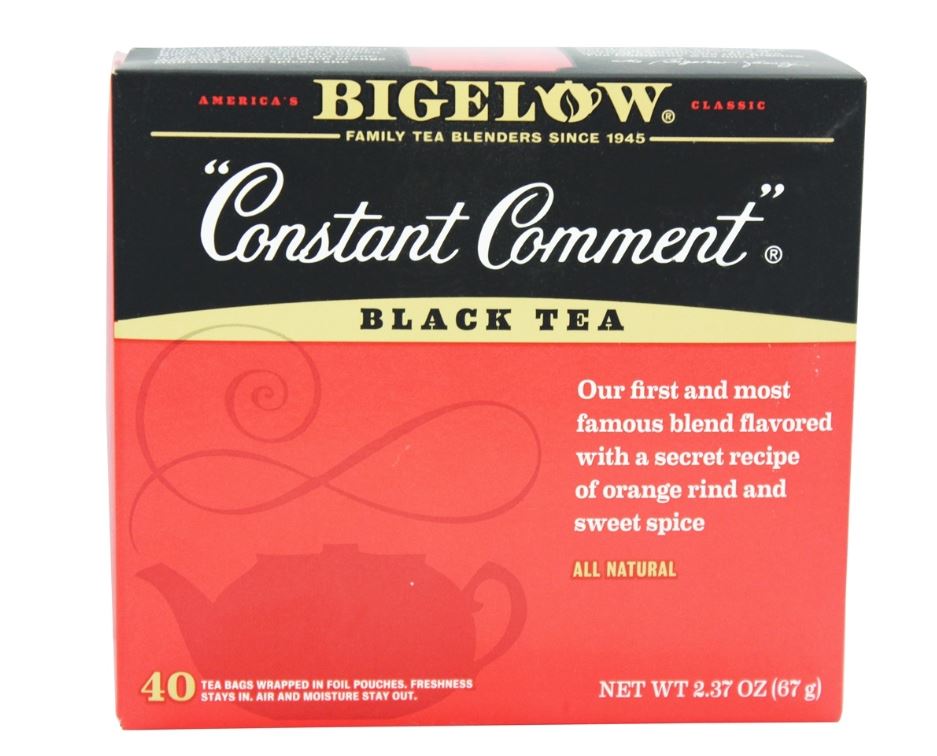











It works!
Recommended by a friend
trying a new brand of zinc lozenge
Good for colds etc..